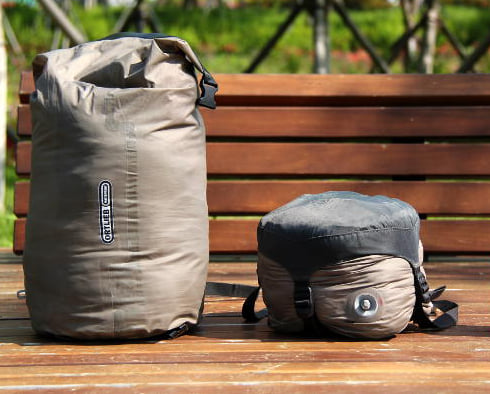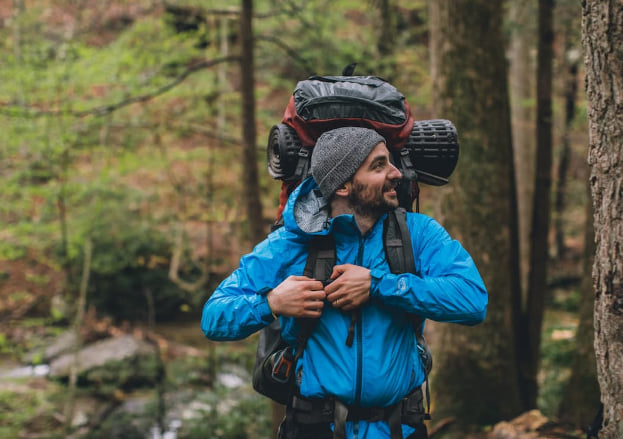As an avid hiker and outdoor enthusiast, I know how important it is to properly pack your gear, especially a technical jacket like those made by Mountain Hardwear. Their jackets are designed for alpine environments, so you need to take care to pack them right if you want your Mountain Hardwear jacket to perform on the trail.
After years of stuffing jackets into packs, squeezing them into suitcases, and lugging gear all over the world, I’ve learned a few tricks for packing Mountain Hardwear jackets so they take up minimal space but still bounce back ready for the next trek. Here are my top tips for getting the most out of your Mountain Hardwear jacket, no matter where your travels take you.
How to Pack Your Mountain Hardwear Jacket for Any Adventure
Pack It Into Its Own Pocket

Many Mountain Hardwear jackets have zippered pockets designed specifically for stuffing the entire jacket into. Simply turn the jacket inside out, then roll it up tightly from the bottom. Keep rolling until you have a tight bundle, then carefully stuff it into the designated pocket. Zip it up and voila! You have a neatly packed jacket taking up minimal space.
I love this method because it keeps the jacket protected and compressed. The material doesn’t catch on other gear, plus it stays clean inside the pocket. It takes a few tries to master the rolling technique, but once you get the hang of it, you can pack your jacket this way in less than a minute. No need for extra equipment or bags. Just make sure to carefully unzip the pocket once you’re ready to wear the jacket again so you don’t damage the zipper.
Utilize Your Backpack’s Main Compartment
For shorter trips, I often just pack my Mountain Hardwear jacket right into my backpack’s main compartment. I place it at the bottom, then layer my other gear on top. The weight of the gear helps compress the jacket. Just be sure not to overload the pack too much or cram the jacket into a corner. It needs a bit of room to loft back up when you take it out.
I like this method for weekend trips or hikes where I don’t need to maximize every inch of pack space. It’s fast, keeps the jacket accessible, and as long as you are mindful about how you pack the rest of the bag, it prevents too much wrinkling. Though it takes up more space than using the built-in pocket, you can still fit plenty of other items around the jacket.
Use Compression Sacks or Packing Cubes

For longer trips and flights where luggage space is tight, I recommend using a compression sack or packing cube to flatten your Mountain Hardwear jacket as much as possible. Simply lay the jacket flat, then roll it up tightly to squeeze out excess air. Slide the rolled jacket into the compression sack or cube and cinch it down.
This forces all remaining air out and compresses the jacket into a smaller, denser package. Just be careful not to pull the cords too tightly or the fabric may become misshapen. The jacket will inflate back to its original size and shape once unpacked. Using compression methods like this, I can easily get my bulky down jacket into a bag or suitcase without taking up my whole luggage allowance.
Consider Weather and Destination

How and where you pack your Mountain Hardwear jacket depends a lot on the climate and conditions you’ll be facing. Are you heading somewhere warm or cold? Wet or dry? Will you need to access the jacket frequently or just at camp?
For cold weather trips, I try to keep my jacket accessible, often wearing it onto the plane or keeping it at the top of my backpack. For warm weather travel, it usually goes at the bottom of my pack or in a compression sack to keep it contained.
I also consider what other gear I’m packing. Bulky items like tents and sleeping bags often force me to get creative with packing my jacket in existing nooks and crannies versus having it take up prime real estate in my bag or case. Taking the time to consider weather, destination, and total luggage contents helps me determine the optimal way to pack my jacket.
The Pros and Cons of Rolling vs. Stuffing
When it comes to packing your Mountain Hardwear jacket into its own pocket or a compression sack, you have two main options – rolling or stuffing. What are the relative pros and cons of each method?
Rolling
Pros:
- Removes more air, creating a smaller packed size
- Reduces wrinkles
- Quicker to unpack and repack
- Easier to control and prevent jamming zippers
Cons
- Takes more time to master the technique
- Can damage fabric or insulation if rolled too tightly
Stuffing
Pros:
- Faster and easier for most people to do
- Can cram into smaller spaces by manually shaping
- Forces out air
Cons:
- Causes more wrinkles
- Can damage fabric and insulation if too much force is used
- Harder to unzip and repack
I generally prefer the rolling technique for my Mountain Hardwear jackets because it makes the jackets easier to repack later, with less wrinkling. However, on those mornings when I’m racing to pack up camp at sunrise, I’ll often just quickly stuff the jacket to save time. Both work perfectly fine, so choose the method that best suits your trip.
Packing Your Jacket for Different Adventure Types

How you pack your Mountain Hardwear jacket doesn’t just depend on the methods and gear you use. It also depends on the activity. The length of your trip, mode of transport, and how often you’ll need the jacket are key considerations. Here are some of my tips for packing a Mountain Hardwear jacket specifically for common outdoor adventures:
Day Hiking
For most day hikes, I simply tie my jacket around my waist or stash it into one of my backpack’s exterior pockets for easy access. If it’s cold out, I wear it from the start. I want my jacket readily available since weather can change quickly in the mountains.
If I’m hiking on a warm day when I likely won’t need my jacket, I’ll lightly roll it and place it at the top of my pack. This way I can grab it quickly if conditions worsen but it doesn’t take up too much precious space.
Backpacking
For backpacking trips, my jacket usually goes inside my backpack, either stuffed into its own pocket or lightly rolled in the bottom of the main compartment. I don’t want it filling up too much interior space but still easily accessible in case we get storms at night.
If I anticipate significant rain or humidity, I may use a waterproof compression sack to help keep my down jacket dry inside my pack. Nothing ruins a trip quicker than soaked, useless gear!
Winter Sports
When I’m doing serious cold-weather sports like ice climbing or backcountry skiing, my puffy jacket becomes top priority. It lives around my waist or in an outside pack pocket for instant access. Otherwise it goes into an internal chest pocket on my ski jacket.
The last thing you want is to have a soaked jacket freeze or to spend fifteen minutes digging it out of your pack in a blizzard. Easy access is a must!
Travel and Urban Use
For travel and urban use, space optimization becomes priority number one. I stuff it into its own pocket then use packing cubes and compression sacks to minimize its size. I want all of my gear streamlined in my luggage.
I may keep it in a backpack or purse when moving between destinations for warmth on chilly commutes or transit time. But mostly my jacket spends travel days neatly packed up.
Winter Expeditions
During hardcore winter expeditions, like mountaineering trips, I take extra precautions to keep my jacket in prime condition. It stays in an internal pack pocket, separate from the exterior gear like ropes and crampons that could snag or tear it. I also waterproof the pack to prevent any moisture from compromising the down.
When stopping to set up camp, I carefully lay out the jacket on the tent floor until I’m ready to don it. Keeping your top insulating layer in flawless condition is critical in frigid, high-consequence environments!
Final Thoughts
I hope these tips help you master packing your Mountain Hardwear jacket effectively and efficiently for your next adventure! Proper packing is just as important as choosing the right technical gear. Treat your jacket with care, keep it clean and dry, and utilize the right packing methods for your situation.
Your Mountain Hardwear jacket is designed to protect you from the harshest alpine environments. By properly packing it for each trip, whether an overnight hike or a month-long expedition, you’ll keep it ready to be your trusty outer layer and summit companion for years to come. Now go get out there, be courageous, and create legendary adventures! Just remember to pack smart.
Your FAQs on Packing Mountain Hardwear Jackets, Answered
How can I get the jacket back to normal shape after packing it for a while?
Gently hang or lay flat the jacket and let it air out to allow insulation to fully loft and wrinkles to release. You can also tumble dry low with tennis balls to fluff it back up. Steaming may help relax creases from folds or rolls as well.
Does packing it ruin the water resistant treatment?
As long as you are packing it dry and avoiding abrasion damage, the durable water repellent (DWR) treatment should remain intact. Over time, washing and use will degrade DWR so it will need to be reapplied. Watch for wetting out.
Can I put it in my hiking backpack without any special bags?
Absolutely! The jacket is designed to withstand being loosely packed into a backpack without any special treatment. Just be cautious of abrasion from zippers, hydration packs, etc. And watch for odor buildup over time.
How do I wash it after trips without damaging the jacket?
It’s best to wash in cold water delicate cycle and air dry. Use a mild detergent without dye or fragrances. Review the specific care label as washing guidance can vary by jacket model. You can also use technical cleaners like Nikwax to revitalize DWR.
Is it better to pack the jacket compressed or loose?
For short trips, loose is fine to make it easily accessible. For longer storage or space savings, compressing into a stuff sack removes excess air. Just be careful not to over-compress insulation. And allow time to fully loft afterward.
Can I just wad it up and stuff it in my pack?
For a very lightweight jacket, a wad may work but it will be prone to odor buildup faster. Take care not to crumple it so tightly that it strains seams or insulation. Folding or rolling is gentler long term.
Will packing it wear out the fabric faster over time?
With reasonable care, Mountain Hardwear jackets are made of quite durable fabrics that can handle normal packing cycles. But improper storage when wet, UV light exposure, abrasion, and dirt will degrade it faster.
How can I keep it clean and dry inside my dirty backpack?
Line your pack interior with a heavy duty plastic bag or waterproof pack liner. Pack your jacket inside to isolate it. Some also use an additional waterproof stuff sack around the jacket for added protection.
Can I pack it at the bottom of my bag or will that get it too compressed?
For short durations, the bottom is okay, but prolonged compression from weight above can damage insulation loft. Pack more lightly, use a frame, or place dense heavy items on bottom with your jacket layered above.



